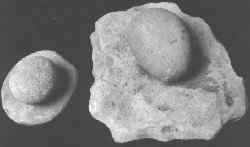Ngadjon Weapons and Tools
Note: this site contains images of aboriginal people now deceasedNgadjon Weapons and Tools
Some of the tools that the Ngadjonji produced from the materials of the forest and used to help them in obtaining and preparing food and in other ways to make their lives more secure and comfortable are introduced in this page.The Ngadjonji made a great variety of spear types and were highly skilled in their use.





Spearpoints & Woomera - George Davis
& Eacham Historical Society
Photos - M.Huxley and K.Mackay
In most cases the spear shafts and points were made of different materials.
Straight lengths of lighter hardwoods such as jiman were favoured for shafts, though in recent years bamboo has become an acceptable substitute for lighter spears.
The spear points were usually made from the very hard wood of jidu, julu or junjum. These were further hardened by burning in a fire and scraping off the charred surface to form the point.
Points were attached to the shafts using fine split lawyer cane binding and special resins. There were many different designs for spear points and their arrangement on the shaft - each for its particular purpose.
Heavy killing spears for hunting large animals or serious fighting would have a single point and were often (shaft and point) made from a single length of hardwood. Fishing spears and spears for hunting smaller animals and birds were lighter and often had multiple points.
The Ngadjonji were very adept in the use of spear-throwers (woomeras) which were used to greatly increase the force and speed of the throw.

Photo - M.Huxley
The picture on the left shows Shane Barlow with a large wooden sword and painted shield made to traditional patterns by Malanbarra Yidinyji Elder George Davis.

Photo - Tony Irvine
Such swords and shields were used mostly for the somewhat ritualised combat at intertribal corroborees (warrima). Shields were made from the relatively light and soft wood from the flange buttresses of fig trees such as magurra, shown in the photo on the right. gabi and other figs were also used for shields. (See Making a shield)
Swords were made of much harder wood from trees such as jidu and junjum.

Boomerangs, used sometimes for fighting and rarely for hunting, were made from carefully selected sections of the flange buttresses of hardwood trees such as dunu.
Boomerang by George Davis; Photo - M.Huxley
Stone axes were highly-prized and very useful tools for the Ngadjonji.

Axe courtesy Eacham Historical Society; Photo - M.Huxley
They were used mostly for woodworking - to cut out and dress the wood needed for making shields, swords, spear points and boomerangs and for removing the sheets of bark used for making blankets. They were not usually used for fighting.
The stone axe head was ground to an edge at each end with a groove ground around the middle for the strap which attached the head to the handle.
The handles were usually made from the robust lawyercanes jungganyu or nidu. A strap of the handle cane was wrapped around the central groove in the head and bound in place using strips of yapulam or barrga. (See Lawyercanes)

String by George Davis; Photo - M.Huxley
String was made from the inner bark of dagurrba. Strips of bark were removed from the tree using an axe. The outer bark was scraped away and the remaining strips of soft moist inner bark were hand rolled on the thigh to form the string. Numbers of these strands could be twisted together to produce a thicker string if desired.
String was used for body decoration, ties of various sorts, and could be woven into taps for fish and birds as an alternative to the lawyercanes.


Grinding stones and graters were used for food preparation, particularly for grinding or grating cooked poisonous seeds before the period of leaching in running water which was necessary to remove the poison before they could be eaten. Snail shell parers were also used for this purpose, especially with ganyjuu. (See Food Processing)
Grinding stones were also used to powder the variously coloured ochres which were used for painting traditional patterns on shields and other wooden artefacts. (See Making a Shield)
Grinding stones & grater courtesy Eacham Historical Society; Photos - K.Mackay
Other important tools for the Ngadjonji included baskets of various kinds (see Basket making), lawyercane traps for catching ground-dwelling birds, eels and other fish, pointed hardwood digging sticks for yams and other food roots, ringing hardwood clapping sticks, firesticks (see Fire) and carved & painted message sticks used to invite surrounding tribes to a warrima.
More information on the tools and weapons of the North Queensland rainforest Aborigines can be found in Aboriginal Tools of the Rainforest by the Aboriginal people of Jumbun, compiled and photographed by Helen Pedley. ISBN 0724278044 at the National Library of Australia TROVE (if you can afford a return airfare to Canberra - reading room only or the State Library of Queensland - but held in Brisbane!)

